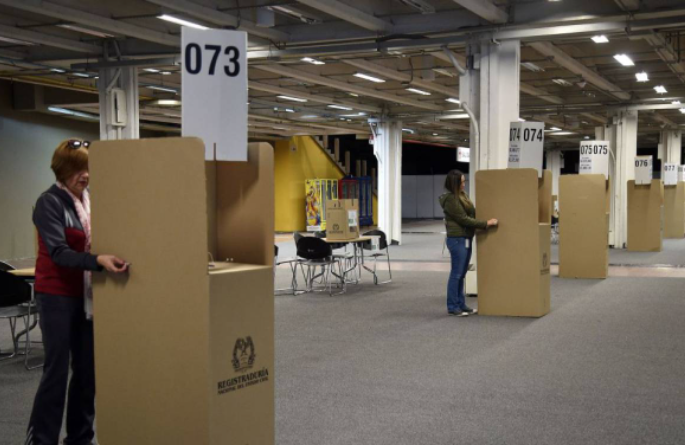The upcoming presidential elections in Colombia will put an end to four years of democratic involution and inaction by President Iván Duque, who leaves a country in a worse situation than the one he inherited. This is unacceptable when, precisely, his predecessor, Juan Manuel Santos, had managed, throughout his eight years of presidency, to improve all social and economic indicators of the country, in addition to closing a peace process with the FARC-EP that put an end to the longest and most violent armed conflict in the continent.
During Iván Duque’s four years in office, the country’s external image has lost ground. Although he has tried to project his image before the main international organizations as a president committed to peace and social prosperity, there is a clear dissonance between his discourse and reality.
Undoubtedly, his condition as a pro-Uribe candidate (related to Álvaro Uribe Velez), which is how he came to the presidency, forced him to renounce many of the milestones achieved during the 2010-2018 period. First, and for obvious reasons, his government questioned the essence of the Peace Agreement. That is why his government’s maxim was “peace with legality” while questioning the legal integrity of the Agreement.
Duque’s government exercised low-intensity institutional sabotage toward those points of the Agreement that most irritated conservatism and Uribism in particular, such as transitional justice, the truth commission, or the political participation of ex-combatants. In fact, according to the Kroc Institute of the University of Notre Dame, in charge of monitoring the implementation of peace, the level of full compliance of this government has been 2% per year.
On the other hand, in terms of security and public order, the country is considerably more violent than it was four years ago. The apparent response based on the militarization of security, which attempts to fallaciously exhibit the capabilities of a “strong” State, rather reveals the lack of a road map adapted to the demands of the post-Agreement.
Experience tells us that, after the signing of the Peace Agreement, violence usually increases. The control of territory, the atomization of the dispute for illicit resources among the actors, and the de-ideologization of the dissident groups added to the institutional precariousness, end up being unattended priorities and urgencies.
But the government acted as if nothing had changed, and instead of taking advantage of the Agreement to promote new public policies in favor of strengthening territorial decentralization, local democracy, and the recomposition of the social fabric, it opted for a simplistic discourse that does not correspond to a reality that demands greater and better response mechanisms.
Thus, in addition to the proliferation of dissidents of the former FARC-EP, criminal groups with a local imprint and an increase in the geography of violence and the operational capabilities of some groups, such as the ELN or the Clan del Golfo, there is also the ineffectiveness of protection schemes. In fact, since the signing of the Peace Agreement in November 2016, almost 2,000 social leaders and more than 300 former members of the FARC-EP have been killed.
On the other hand, social discontent has increased to the point of fueling two national strikes, in 2019 and 2021, in addition to a multitude of episodes of citizen protests and street demonstrations that have shown the incapacity for dialogue with a government that continues to understand that rights are the patrimony of concession and that social conflict is synonymous with violence. This procedure is in order to avoid recognizing mechanisms of dialogue and recognition with civil society and, rather, to claim the need for greater militarization needs, with the corresponding criminalization of protest.
But, the reality is different. The Peace Agreement, beyond ending the conflict with the FARC-EP, has served to open a new scenario for social and political demands that for decades have been overshadowed by violence. In the same way, it offers citizens the availability of new mobilization repertoires, devoid of the presence of armed actors, while freeing space for the left that, in principle, should serve to improve the quality of democracy in Colombia.
However, all the aforementioned situations do not go beyond the level of supposition, since, according to several measures of democratic and electoral quality, the premise of understanding that democracy improves after the signing of a Peace Agreement, in the case of Colombia, yields more than questionable results.
The pandemic has also served to show the contradictions and weaknesses of one of the most unequal countries in the world. The multidimensional poverty index is among the worst on the planet and the thresholds of the population below the poverty line have fallen back almost two decades, exceeding 40%. Of course, a deeply (re)centralized State does not help, where labor informality affects almost two-thirds of the population and whose tax structure is one of the most regressive in the continent.
This intricate scenario is the one that the future president will have to face. But first, the electoral dispute must be settled, which, in the first round, everything suggests that it will be the former mayor of Bogotá, Gustavo Petro, who will be the most voted force. However, it is unlikely that he will obtain more than 50%, so the final result will be decided in the second round scheduled for June 19.
On the other hand, the most reliable polls show the conservative Federico Gutierrez as the second most voted candidate. This was inconceivable a few months ago when it seemed that the Colombian presidency would be disputed between Gustavo Petro and Sergio Fajardo. However, Fajardo’s downward trend has been inversely proportional to the support that Gutiérrez has obtained from media such as Semana or RCN, from traditional parties such as the Liberal Party and the Conservative Party, as well as from former presidents César Gaviria or Andrés Pastrana.
It is as if during the last two months the maxim “everyone against Petro” has allowed closing ranks around a candidate capable of overlapping dissimilar extremes.
Three factors that will decide the election
There are three factors that will decide the election. First, the mobilization capacity, favorable but also unfavorable, accompanies Gustavo Petro. His campaign mistakes and the bet on Francia Márquez as vice-president, although they have consolidated his left-wing position, have hindered any shift to the center.
Second, it has to be seen what happens with the behavior of the more moderate voter, initially aligned with Sergio Fajardo’s Centro Esperanza Coalition, and who has to move on a deeply centrifugal and highly polarized continuum. Third, and as a counterweight, would be the very low favorability of Iván Duque, whose natural successor would be Gutiérrez.
In conclusion, in view of the inheritance that the next president will receive, what is at stake in the next elections seems to gravitate between continuity and rupture. The continuity of Federico Gutiérrez, aligned with the deregulation of the market, the minimal State, the more traditional security policy, and the geopolitical proximity with the United States. Or the rupture of Gustavo Petro, in favor of recovering the path of the Peace Agreement, strengthening the territorial and institutional dimension of the State, and promoting a public policy that bets on greater social cohesion and higher public spending. In a few weeks, we will know for sure.
Translated from Spanish by Janaína Ruviaro da Silva












